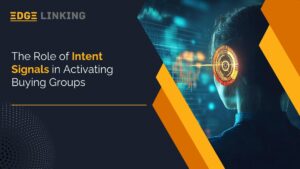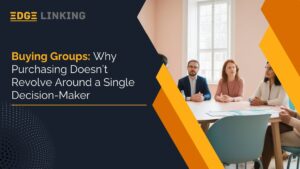You are running a B2B campaign focused on generating leads. You are seeking 5% buyers who are ready to purchase right now. These are the buyers who fill out forms, request demos, or are ready to sign a contract. But we overlook the rest, the 95% who can become opportunities, not ready to buy but can be pursued. This is the concept of the 95 -5 rule in B2B marketing.
In B2B marketing, we prioritize short-term results. Budgets are tight, KPIs are tied to quarterly targets, and sales teams need leads now. But we need to give equal importance to 95% of buyers. Why? When that 95% move into the buying phase, they’ll likely choose a brand they’ve already heard of, trust, and associate with value. If your brand isn’t in their minds by then, you’ve lost the sale before it even began. Focusing solely on the 5% is like fishing in a pond with a handful of fish while ignoring the ocean next to it.
This article will discuss the 95-5 rule and the importance of focusing on the remaining 95% of B2B buyers.
What is the 95-5 Rule in the B2B?
The 95-5 Rule suggests that 5% of your potential B2B buyers are in-market, while 95% are out-of-market and currently not looking to make a purchase. However, this larger segment is the future buyers who are silently researching, building internal business cases, or simply not aware that they have a problem you can solve.
95-5 rule marketing is gaining ground among B2B marketers. It works on a dual strategy: continue capturing in-market buyers while investing in brand awareness, relevant content, and engagement for 95%. The real long-term growth lies in building relationships and brand familiarity with 95% of your B2B buyers.
Why the 95% of B2B Buyers Are Important
Here’s why 95% of B2B buyers are critical.
1.Future Revenue Lies Within the 95%
Most B2B buying decisions are planned months in advance. By staying top-of-mind with the 95%, you position your brand for when they’re finally ready to make a move.
Example: An organization that sells cloud security solutions might not be of interest to a midsize business today. But they’ll be looking for a trusted vendor when they grow or update tech infrastructure next year.
2.Brand Familiarity Drives Purchase Decisions
When B2B buyers look for solutions, they often use brands they recognize and trust. You will have a competitive edge if you’ve built brand awareness with 95% through thought leadership and consistent visibility.
Example: A procurement manager shortlisting software vendors will consider a brand they’ve seen mentioned in industry webinars or whitepapers, even if they weren’t ready to buy six months ago.
3.The Buying Journey is Long
B2B purchases often involve multiple stakeholders and long decision-making cycles. Many of the 95% are in the early awareness phase. Helping them during these stages builds credibility and nurtures long-term trust.
Example: A CFO exploring automation tools may start by reading general blogs. If you provide helpful insights over time, they’ll likely shortlist your solution when budget planning begins.
4.Playing the Long Game Yields Compounding Returns
While sales teams chase immediate deals (the 5%), marketers who invest in the 95% see bigger returns. Long-term brand-building strategies create an effect of trust and preference.
Example: HubSpot built a content ecosystem that educated the 95%, which later converted into paying customers when needed.
5.You Reduce Acquisition Costs in the Long Run
Capturing attention when buyers are not overwhelmed with vendor pitches is cheaper and more effective. If you wait until everyone is competing for the same 5%, your cost per lead goes up.
Example: If your brand is already known and trusted by a CIO before they enter the market, you will not need aggressive discounts or paid campaigns to win their attention.
6.The 95% Influence the 5%
Even if someone isn’t the final decision-maker today, they could influence those who are. Nurturing 95% increases your reach across the organization and builds internal advocates.
Example: A junior IT analyst reading your blogs today might recommend your solution to their manager when a buying decision is discussed next quarter.
Features of the 95-5 Rule in B2B
Below are the features of the 95-5 rule for B2B.
1.Market Size Awareness
Feature: The 95-5 Rule highlights that most of your potential audience isn’t ready to buy today.
Example: Most businesses do not want to switch platforms if you’re marketing enterprise project management software. However, over the next 12–24 months, many of them will be in the market.
2.Focus on Long-Term Brand Building
Feature: The Rule encourages brand awareness for the 95% who are not yet buyers.
Example: A SaaS company that sells HR software creates helpful guides on performance reviews or compliance. Even if HR managers don’t need new software today, they see you as a knowledgeable brand.
3.Dual Marketing Strategy
Feature: You need two strategies—one for the 5% ready to buy and one for the 95% not.
Example: A cybersecurity firm runs Google Ads targeting the 5% searching “buy threat detection software” while also investing in LinkedIn thought leadership for the 95% exploring trends.
4.Buying Triggers Are Unpredictable
Feature: You never know when someone in the 95% will suddenly shift into the 5%.
Example: A company experiencing a data breach may suddenly seek solutions. If your brand has already spread awareness through webinars or newsletters, they will approach you.
5.Trust Grows Before Demand
Feature: Trust is built long before purchase intent arises, making it essential to connect early.
Example: A CFO might read your insights on financial automation for months. When their ERP system goes up for review, they trust your voice and will reach out.
Difference in POV on 95:5 Rule: Marketing vs. Demand Gen
While both share the goal of driving business growth, their views on the 95:5 Rule often differ in strategy, timing, and focus.
1.Focus Area: Long-Term vs. Short-Term
Marketing POV:
Marketing teams view the 95% (out-of-market buyers) as a long-term opportunity. They focus on brand awareness, thought leadership, and building trust.
Example: A marketing team at a SaaS company invests in a branded content series on YouTube for finance professionals, knowing that most viewers might be interested in 6–12 months.
Demand Gen POV:
Demand Gen focuses on 5% and aims to capture leads and generate a pipeline immediately.
Example: The Demand Gen team runs paid search ads targeting keywords like “best FP&A software” and offers demos and whitepapers in exchange for contact details.
2.Measurement of Success
Marketing POV:
Success is measured by reach and engagement indicators that show growing awareness among future buyers.
Example: A B2B cybersecurity company tracks content views, social shares, and brand recall among CISOs over quarters.
Demand Gen POV:
Conversions, MQLs, and pipeline attribution measure success.
Example: The same company’s Demand Gen team measures the number of demo requests received this month and which campaigns generated SQLs.
3.Messaging Strategy
Marketing POV:
Messaging is educational, thought-provoking, and designed to spark curiosity.
Example: A B2B cloud provider publishes a blog series on “How AI Will Transform Infrastructure in 5 Years.”
Demand Gen POV:
Messaging is action-oriented, focused on value and solving pain points.
Example: That same cloud provider runs ads like “Reduce Infrastructure Costs by 30% – Get a Free Assessment.”
4.Time Horizon
Marketing POV:
Sees the 95-5 rule marketing strategy as a long-term investment. Results grow over quarters and years.
Demand Gen POV:
Needs results in weeks, sometimes even days, to meet short-term goals and pipeline targets.
Conclusion
B2B isn’t just about capturing leads; it’s about earning mindshare long before a buyer enters the funnel. In a competitive space, you win when you think ahead, speak to future buyers, and position yourself as a credible partner.
So, as you plan your next campaign, ask yourself: Are we only chasing the 5%, or are we investing in the 95% too? Make the 95% a priority because your future customers are already listening.
The 95% Won’t Click Today — But They’ll Remember You Tomorrow.






